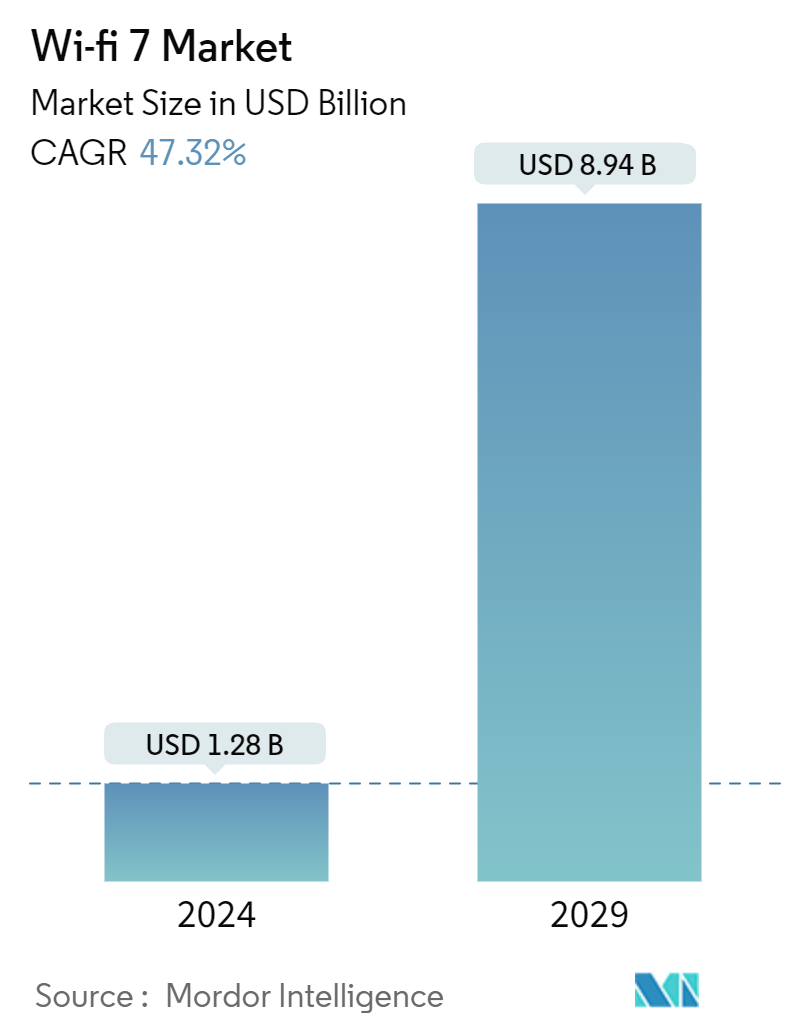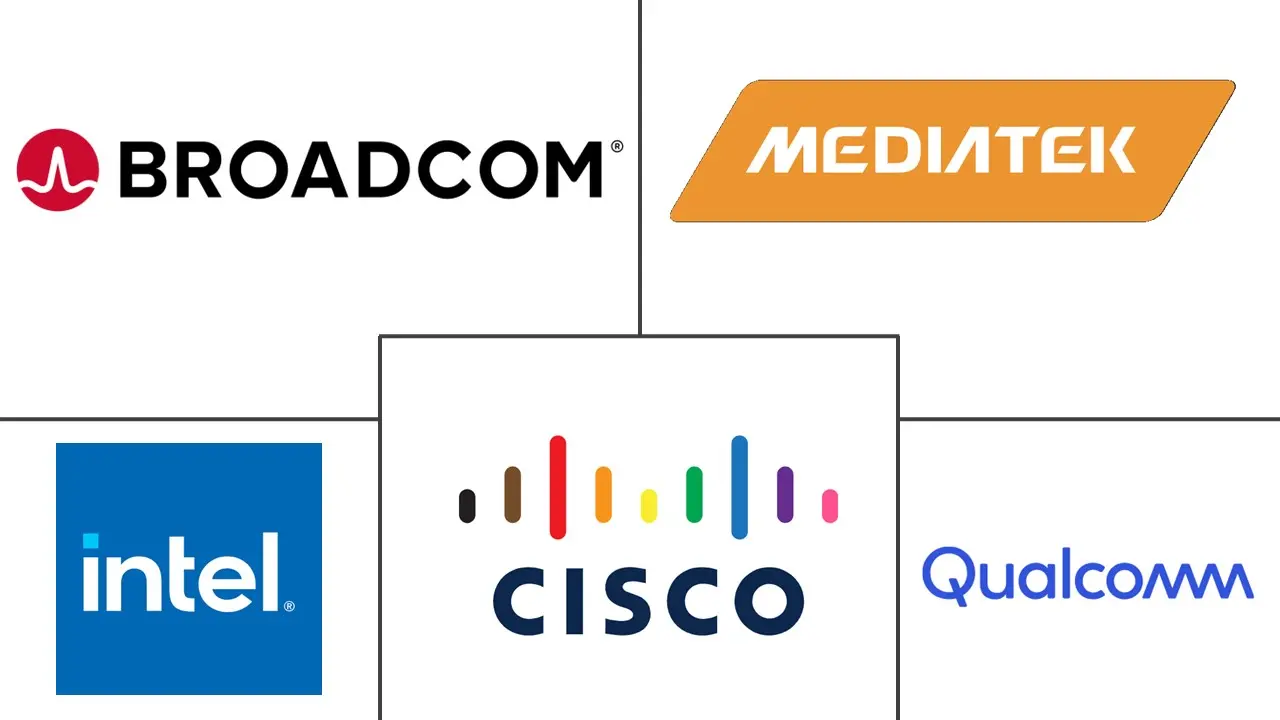Market Size of Wi-fi 7 Industry

| Study Period | 2019 - 2029 |
| Market Size (2024) | USD 1.28 Billion |
| Market Size (2029) | USD 8.94 Billion |
| CAGR (2024 - 2029) | 47.32 % |
| Fastest Growing Market | Asia Pacific |
| Largest Market | North America |
| Market Concentration | High |
Major Players
*Disclaimer: Major Players sorted in no particular order |
Wi-fi 7 Market Analysis
The Wi-fi 7 Market size is estimated at USD 1.28 billion in 2024, and is expected to reach USD 8.94 billion by 2029, growing at a CAGR of 47.32% during the forecast period (2024-2029).
- Wi-Fi 7 is known as the IEEE standard 802.11be. It works with several different radio frequencies, including 2.4GHz, 5GHz, and 6GHz. It offers links at a maximum speed of 40,000 Mbit/s. The quality and resolution of video streaming are improved by 16 spatial streams and Multiple Input Multiple Output (MIMO) technology. Hybrid Automatic Repeat Request (HARQ), a feature of Wi-Fi 7, facilitates multiple link adaptation.
- The upcoming revision of the IEEE 802.11 standard, called IEEE 802.11be, is Extremely High Throughput (EHT). On top of 802.11ax, it will emphasize WLAN indoor and outdoor operating at pedestrian and stationary speeds in the 2.4, 5, and 6 GHz frequency bands. It is anticipated that the speeds will match Thunderbolt at 40 Gbps.
- The throughput needed for video distribution will continue to rise to tens of Gbps with the introduction of 4k/8k video. Online gaming, augmented reality (AR), virtual reality (VR), and other fresh, high-throughput, and low-latency video applications are also exploding. Supporting these applications over a wireless local area network (WLAN) is much beyond the capabilities of the latest WLAN standard, IEEE 802.11ax, because of the associated strict requirements.
- The IEEE 802.11 will publish a new amendment standard, IEEE 802.11be - Extremely High Throughput (EHT), often known as Wireless-Fidelity (Wi-Fi) 7, to satisfy these growing demands. A growing number of customers are engaging in e-commerce transactions, web browsing, mobile learning, and other online-related activities, driving the demand for faster internet access. As a result, the wireless router, frequently utilized in laptops, PCs, and tablets, has become essential for human existence. Wi-Fi routers are mostly responsible for the rising need among consumers to stay linked to dependable Internet and for enhancing Wi-Fi connections in numerous nations.
- Moreover, the increasing use of connected devices in healthcare, education, business, financial services, and other applications is one of the key drivers of the worldwide Wi-Fi 7 market. Additionally, the market growth is positively impacted by small and medium businesses adopting a bring your device policy. Further, during the projected period, a surge in government initiatives for smart city projects is anticipated to create lucrative opportunities for market expansion.
Wi-fi 7 Industry Segmentation
Wi-Fi, short for wireless fidelity, is a wireless technology that connects devices to the internet or local networks via radio waves. It enables wireless communication for various devices in homes, businesses, and public spaces.
The global Wi-Fi 7 market is segmented by type (hardware and service), by application (indoor and outdoor), and by region (North America, Europe, Asia-Pacific, Latin America and Middle East and Africa).
The market sizes and forecasts are provided in terms of value (USD) for all the above segments.
| By Type | |||||
| |||||
| Services |
| By Application | |
| Indoor | |
| Outdoor |
| By Geography*** | |
| North America | |
| Europe | |
| Asia | |
| Australia and New Zealand | |
| Latin America | |
| Middle East and Africa |
Wi-fi 7 Market Size Summary
The Wi-Fi 7 market is poised for substantial growth, driven by the increasing demand for high-speed internet connectivity to support advanced applications such as 4K/8K video streaming, online gaming, augmented reality, and virtual reality. As the IEEE 802.11be standard, Wi-Fi 7 is set to offer Extremely High Throughput (EHT) capabilities, operating across multiple frequency bands and delivering speeds that match Thunderbolt technology. This evolution is crucial as the current WLAN standards struggle to meet the stringent requirements of these high-throughput applications. The proliferation of connected devices across sectors like healthcare, education, and business, coupled with the rise of smart city initiatives, is further propelling the demand for Wi-Fi 7. The market is also benefiting from the increasing adoption of bring-your-own-device policies in small and medium enterprises, which underscores the need for robust and reliable wireless connectivity.
In North America, the Wi-Fi 7 market is experiencing significant momentum due to the adoption of smart factories and smart homes, which require high bandwidth and low-latency solutions. The region's focus on energy efficiency and low-emission solutions is driving the demand for smart devices, thereby creating opportunities for Wi-Fi 7 technology. Major players in the market, such as Broadcom, Qualcomm, and MediaTek, are actively developing and releasing advanced Wi-Fi 7 chipsets to cater to this growing demand. These companies are expanding their product offerings to include a wide range of devices, from routers to IoT applications, ensuring they maintain a competitive edge. The introduction of Wi-Fi 7 is expected to significantly enhance bandwidth capabilities, particularly with the utilization of the 6 GHz spectrum, further solidifying its position in the market.
Wi-fi 7 Market Size - Table of Contents
-
1. MARKET INSIGHTS
-
1.1 Market Overview
-
1.2 Industry Attractiveness - Porter's Five Forces Analysis
-
1.2.1 Bargaining Power of Buyers
-
1.2.2 Bargaining Power of Suppliers
-
1.2.3 Threat of New Entrants
-
1.2.4 Threat of Substitutes
-
1.2.5 Intensity of Competitive Rivalry
-
-
1.3 Evolution of Wi-Fi Standards and Regulations
-
1.4 Macro Economic Factors Impacting the market
-
-
2. MARKET SEGMENTATION
-
2.1 By Type
-
2.1.1 Hardware
-
2.1.1.1 Access Points
-
2.1.1.2 Gateways
-
2.1.1.3 Routers and Extenders
-
-
2.1.2 Services
-
-
2.2 By Application
-
2.2.1 Indoor
-
2.2.2 Outdoor
-
-
2.3 By Geography***
-
2.3.1 North America
-
2.3.2 Europe
-
2.3.3 Asia
-
2.3.4 Australia and New Zealand
-
2.3.5 Latin America
-
2.3.6 Middle East and Africa
-
-
Wi-fi 7 Market Size FAQs
How big is the Wi-fi 7 Market?
The Wi-fi 7 Market size is expected to reach USD 1.28 billion in 2024 and grow at a CAGR of 47.32% to reach USD 8.94 billion by 2029.
What is the current Wi-fi 7 Market size?
In 2024, the Wi-fi 7 Market size is expected to reach USD 1.28 billion.

